THE SEVEN WONDERS OF
BARSOOM SERIES
THE HOTHOUSE CITIES OF OKAR:
The Third Wonder of Barsoom
by
Woodrow Edgar Nichols, Jr.

INTRODUCTION

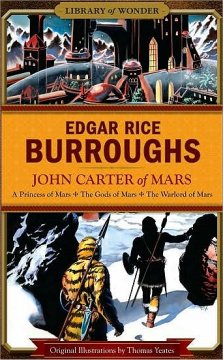
Thomas Yeates art for the John Carter of Mars Trilogy
Edgar Rice Burroughs saved the best for last in his famous
trilogy:
A Princess of Mars, Gods of Mars, and Warlord of Mars.
As Carter fights his way from the South Pole to the North Pole as he tries
to rescue his incomparable princess, Dejah Thoris, and stamp out the false
religion of Issus, he encounters the North Pole's Great Ice Barrier, the
Carrion Caves, and the land of Okar.
Okar is a gloomy, barren world of ice and crevaces which
lies between the pole and the Great Ice Barrier. It is populated by Yellow
Men with beards who live in hothouse cities, which create a man-made paradise
under their crystal-glass domes. It is within these cities that the final
drama of the trilogy is played out and where John Carter becomes the Warlord
of Mars.
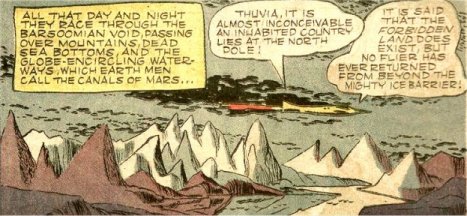 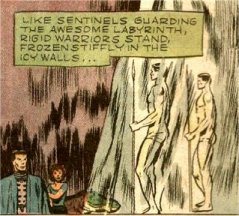
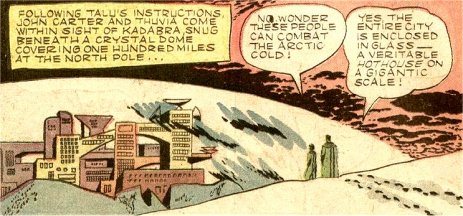 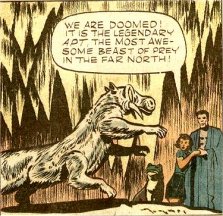
Great Ice Barrier | Carrion Caves | Crystal Dome | Apt ~ Jesse Marsh
art in 1952 Dell Comic

DATA

John Carter, assisted by Thuvan Dihn, Jeddak of Ptarth,
Thuvia’s father, search the border of the Ice Barrier for an entrance to
the land of the North Pole. They are constantly harrassed by arctic monsters,
mainly the apt:
“It is a huge, white-furred
creature with six limbs, four of which, short and heavy, carry it swiftly
over the snow and ice; while the other two, growing forward from its shoulders
on either side of its long, powerful neck, terminate in white, hairless
hands, with which it seizes and holds its prey.
“Its head and mouth are more similar
in appearance to those of a hippopotamus than to any other earthly animal,
except that from the sides of the lower jawbone two mighty horns curve
slightly downward toward the front.
“Its two huge eyes inspired my greatest
curiousity. They extend in two vast, oval patches from the center of the
top of the cranium down either side of the head to below the roots of the
horns, so that these weapons really grow out from the lower part of the
eyes, which are composed of several thousand ocelli each.
“This eye structure seemed remarkable
in a beast whose haunts were upon a glaring field of ice and snow, and
though I found upon minute examination of several that we killed that each
ocellus is furnished with its own lid, and that the animal can at will
close as many of the facets of his huge eyes as he chooses, yet I was positive
that nature had thus equipped him because much of his life was to be spent
in dark, subterranean recesses.” (WM/8.)
They are thwarted in finding an entrance until they come
across the largest apt they have seen yet, standing eight feet at the shoulder
and wearing a golden collar. Unlike all of the other apts, it doesn’t attack
them, but wanders off after seeing them. They deduce that this one has
been tamed by man and follow it, discovering a cave opening. This is the
entrance to the Carrion Caves, the only land entrance to the legendary
land of the Yellow Men, of which there is little knowledge:
“My knowledge of the efforts
that had been made by countless expeditions to explore that unknown land
bade me to caution, for never had flier returned who had passed to any
considerable distance beyond the mighty ice-barrier that fringes the southern
hem of the frigid zone.” (WM//8.)
Carter muses on the disappearance of the fliers:
“The distance from the
barrier to the pole was no more than a swift flier could cover in a few
hours, and so it was assumed that some frightful catastrophe awaited those
who reached the “forbidden land,” as it had become to be called by the
Martians of the outer world.” (WM/8)
The reason for the catastrophe will be a major plot point
later in the story. As they make their way through the last cave, Thuvan
Dihn relates an ancient Barsoomian legend:
“‘The ancient chronicles
of the first historians of Barsoom – so ancient that we have for ages considered
them mythology – record the passing of the yellow men from the ravages
of the green hordes that overran Barsoom as the drying up of the great
oceans drove the dominant races from their strongholds.
“‘They tell of the wanderings of
the remnants of this once powerful race, harassed at every step, until
at last they found a way through the ice-barrier of the north to a fertile
valley at the pole.’” (WM/8.)
As they will discover, only the last part of the chronicles
dealing with a fertile valley is mythology, a fact made clear as Carter
and Thuvan Dihn emerge from the caves:
“Beyond the last cave we
emerged into a desolate country of snow and ice, but found a well-marked
trail leading north. The way was boulder-strewn, as had been that south
of the barrier, so that we could see but a short distance ahead of us at
any time.” (WM/8.)
They espie six Yellow Martians dressed in black and orange
striped furs ambush another Yellow Martian dressed in the pure white skin
of the apt. They rescue the one dressed in white, discovering after the
assassins are killed that he is Talu, the rebel prince of Marentina:
“‘These from whom you have
just saved me are warriors he has sent out to find and slay me, for they
know that often I come alone to hunt and kill the sacred apt which Salensus
Oll so much reveres. It is partly because I hate his religion that Salensus
Oll hates me; but mostly does he fear my growing power and the great faction
which has arisen throughout Okar that would be glad to see me ruler of
Okar and Jeddak of Jeddaks in his place.
“‘He is a cruel and tyrannous master
all hate, and were it not for the great fear they have of him I could raise
an army overnight that would wipe out the few that may remain loyal to
him. My own people are faithful to me, and the little valley of Marentina
has paid no tribute to the court of Salensus Oll for a year.
“‘Nor can he force us, for a dozen
men may hold the narrow way to Marentina against a million.’” (WM/9.)
Talu convinces Carter and Thuvan Dihn that it is expedient
to visit his city of Marentina before they proceed on to the capital city
of Kadabra. It is likely that in Kadabra they will find Dejah Thoris and
Thuvia since Salensus Oll is a radical believer in Issus and would have
easily given aid and comfort to the leader of the Holy Therns.
A. Marentina.
In Marentina, Carter discovers his first hothouse city
and marvels at its beauty:
“The way was over some
of the worst traveling I have ever seen, and I do not wonder that in this
land where there are neither thoats nor fliers that Marentina is in little
fear of invasion; but at last we reached our destination, the first view
of which I had from a slight elevation a half-mile from the city.
“Nestled in a deep valley lay a
city of Martian concrete, whose every street and plaza and open space was
roofed with glass. All about lay snow and ice, but there was none upon
the rounded domelike, crystal covering that enveloped the whole city.
“Then I saw how these people combatted
the rigors of the arctic, and lived in luxury and comfort in the midst
of a land of perpetual ice. Their cities were virtual hothouses, and when
I had come within this one my respect and admiration for the scientific
and engineering skill of this buried nation was unbounded.” (WM/9.)
Carter discovers that the Yellow Martians are exactly like
the Red, Black, and White Martians except for the color of their skin and
their fierce beards. They stay in Marentina for three days while Talu gives
them a thorough tour of his city:
“The Marentina atmosphere
plant will maintain life indefinitely in the cities of the north pole after
all life upon the balance of dying Mars is extinct through the failure
of the air supply, should the great central plant again cease functioning
as it did upon that memorable occasion that gave me the opportunity of
restoring life and happiness to the strange world that I had already learned
to love so well.
“He showed us the heating system
that stores the sun’s rays in great reservoirs beneath the city, and how
little is necessary to maintain the perpetual summer heat of the glorious
garden spot within this arctic paradise.
“Broad avenues of sod sewn with
the seed of the ocher vegetation of the dead sea bottoms carried the noiseless
traffic of light and airy ground fliers that are the only form of artificial
transportation used north of the gigantic ice-barrier.
“The broad tires of these unique
fliers are but rubber-like gas bags filled with the eighth Barsoomian ray,
or ray of propulsion – that remarkable discovery of the Martians that has
made possible the great fleets of mighty airships that render the red men
of the outer world supreme. It is this ray which propels the inherent or
reflected light of the planet off into space, and when confined gives to
the Martian craft their airy buoyancy.
“The groud fliers of Marentina contain
just sufficient buoyancy in their automobile-like wheels to give the cars
traction for steering purposes; and though the hind wheels are geared to
the engine, and aid in driving the machine, the bulk of this work is carried
by a small propeller at the stern.
“I know of no more delightful sensation
than that of riding in one of these luxuriously appointed cars which skim,
light and airy as feathers, along the soft, mossy avenues of Marentina.
They move with absolute noiselessness between borders of crimson sward
and beneath arching trees gorgeous with the wondrous blooms that mark so
many of the highly cultivated varieties of Barsoomian vegetation.” (WM/9.)
Talu takes them to a barber who gives them fake beards and
a lotion to put on their skin to give them a yellow pigment. Appearing
as Yellow Martians, they are given orange and black striped fur suits made
from the orluk – another arctic monster – and leave Marentina for Kadabra.
Talu gives Carter a special ring that makes a pricking
sensation in his flesh when it comes into close proximity with one of its
mates, worn by Talu's spies in Kadabra.
B. Kadabra.
They travel all day and soon reach their destination:
“That very evening we came
into sight of the walled and glass-roofed city of Kadabra. It lies in a
low depression near the pole, surrounded by rocky, snowclad hills. From
the pass through which we entered the valley we had a splendid view of
this great city of the north. Its crystal domes sparkled in the brilliant
sunlight gleaming above the frost-covered outer wall that circles the entire
one hundred miles of its circumference.
“At regular intervals great gates
give entrance to the city.” (WM/9.)
The gates are all closed for the day and they wait until
the next morning to gain entrance.
They do this by joining a Marentina orluk hunting party
using the ruse Talu suggested, saying they are from Illal, a remote Okarian
city having little or no intercourse with Kadabra. Later that evening the
party returns and it is then that Carter learns why all of the fliers that
had ventured over the great barrier never returned:
“We had come quite close
to the city when my attention was attracted toward a tall, black shaft
that reared its head several hundred feet into the air from what appeared
to be a tangled mass of junk or wreckage, now partially snowcovered.” (WM/9.)
Carter's attention is then directed by the hunting party
to a large flier making its way above the crest of the encircling hills.
The hunting party jokes in wonder at the continued folly of the outside
world and as the flier gets nearer to the shaft, Carter discovers why:
“Straight for that grim
shaft she bore. At the last minute I saw the great blades move to reverse
her, yet on she came as though drawn by some mighty, irresistible power.”
(WM/9.)
Carter then witnesses the gruesome sight of the flier crashing
into the shaft while all the efforts of her crew to escape prove to be
in vain. They all end up at the bottom of the shaft as bent and torn wreckage.
Carter then understands how the shaft works:
“The shaft was a mighty
magnet, and when once a vessel came within the radius of its powerful attraction
for the aluminum steel that enters so largely into the construction of
all Barsoomian craft, no power on earth could prevent such an end as we
had just witnessed.
“I afterward learned that the shaft
rests directly over the magnetic pole of Mars, but whether this adds in
any way to its incalculable power of attraction, I do not know. I am a
fighting man, not a scientist.” (WM/9.)
Carter learns that the shaft is called the Guardian of the
North. Several hundred warriors exit through the nearest gate of the city
and fall upon any survivors, and as Carter and Thuvan Dihn enter the city,
a pack of fierce, gold-collared apts is loosed upon the wreckage to finish
whatever the warriors missed.
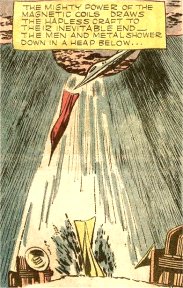 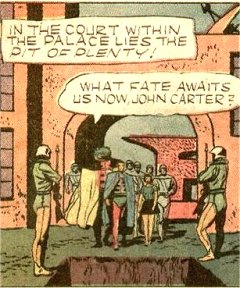
Guardian of the North | Pit of Plenty
After finding a place to sleep for the night, they explore
the city the next day, ending up seeking employment as palace guards in
a magnificent building on the plaza opposite the royal grounds. Talu told
them to seek employment from Sorav, the commander of the forces of the
palace, and Carter discovers some more marvelous inventions as they are
processed by an aid:
“The aid took us to his
own office first, where he measured and weighed and photographed us simultaneously
with a machine ingeniously devised for that purpose, five copies being
instantly reproduced in five different offices of the government, two of
which are located in other cities miles distant.” (WM/10.)
They are locked in a guard tower until they finish being
tested for employment. While in the tower, they look out a barred window
and see Dejah Thoris and Thuvia conversing in the palace garden and try
to contact them, forgetting they are in the disguise of yellow men. After
they are shunned, Thurid arrives and tries to force himself on Dejah Thoris.
This enrages Carter so much he bends the bars on the window and leaps out
into the garden to punch out Thurid. He is subsequently exposed by Thurid,
arrested and sentenced to the Pit of Plenty by Salensus Oll so that he
may marry Dejah Thoris:
“Then they led me through
long corridors to a court far toward the center of the palace.
“In the center of the court was
a deep pit, near the edge of which stood a half dozen other guardsmen,
awaiting me. One of them carried a long rope in his hands, which he commenced
to make ready as we approached.” (WM/11.)
Carter gets a tingling feeling in his finger as he approaches,
tipping him off that one of the guardsmen is one of Talu’s spies. Carter
acts as if nothing has happened and is unceremoniously lowered into the
pit:
“The pit, which my imagination
had pictured as being bottomless, proved to be not more than a hundred
feet in depth; but as its walls were smoothly polished it might as well
been a thousand feet, for I could never hope to escape without outside
assistance.” (WM/11.)
The pit is covered, leaving Carter in utter darkness. Carter
eventually receives outside assistance, but first he learns the sadistic
purpose of the pit:
“For a day I was left in
darkness; and then, quite suddenly a brilliant light illumined my strange
cell. I was reasonably hungry and thirsty by this time, not having tasted
food and drink since the day of my incarceration.
“To my amazement I found the sides
of the pit, that I had thought smooth, lined with shelves, upon which were
the most delicious viands and liquid refreshments that Okar afforded.
“With an exclamation of delight
I sprang forward to partake of some of the welcome food, but ere ever I
reached it the light was extinguished, and, though I groped about the chamber,
my hands came in contact with nothing beside the smooth, hard wall that
I had but felt on my first examination of the prison.
“Immediately the pangs of hunger
and thirst began to assail me. Where before I had but a mild craving for
food and drink, I now actually suffered for want of it, and all because
of the tantalizing sight that I had of food almost within my grasp.
“Once more darkness and silence
enveloped me, a silence that was broken only by a single mocking laugh.”
(WM/11.)
Carter falls for this cruel joke for a few days, almost goes
mad, then recalling the mental fortitude he used in the pits of the Warhoons,
he uses his will-power to resist the urge to lunge for the food, having
learned that the walls are thick glass and the shelves of food are on the
other side. With a rope given to him by Talu’s spy, he ascends out of the
pit into a chamber near the
top, and follows the rope to a strange room where he
discovers Thurid and an old man in conversation. Here he learns the purpose
of the room from Thurid:
“‘You need not more than
step from this room for an instant when I give you the signal. I will do
the rest, and then, when I am gone, you may come and throw the great switch
back in its place, and all will be as before. I need but an hour’s start
to be safe beyond the devilish power that you control in this hidden chamber
beneath the palace of your master. See how easy,’ and with the words the
black dator rose from his seat and, crossing the room, laid his hand upon
a large, burnished lever that protruded from the opposite wall.
“‘No! No!’ cried the little old
man, springing after him, with a wild shriek. ‘Not that one! Not that one!
That controls the sunray tanks, and should you pull it too far down, all
Kadabra would be consumed by heat before I could replace it. Come away!
Come away! You know not with what mighty powers you play. This is the lever
that you seek. Note well the symbol inlaid in white upon its ebon surface.’
“Thurid approached and examined
the handle of the lever.
“‘Ah, a magnet,’ he said.” (WM/12.)
With the help of Talu’s spy, Carter rescues Tardos Mors and
his son, Mors Kajak, the father of Dejah Thoris, from a weapons chamber
where they are chained to a wall. In a desperate fight with the guardsmen,
they seek refuge at the top of the Kadabra watchtower, a high and lofty
tower with walls made out of solid glass. It is in this fight that we learn
why Tardos Mors and Mors Kajak are the greatest fighting Red Martians on
the planet. In the glass-walled tower, Carter can see almost all of Okar:
“From this lofty perch
a view could be had for miles in every direction. Toward the south stretched
the rugged, ice-clad waste to the edge of the mighty barrier. Toward the
east and west, and dimly toward the north I descried other Okarian cities,
while in the immediate foreground, just beyond the walls of Kadabra, the
grim guardian shaft reared its somber head.” (WM/12.)
Carter then witnesses the land forces of Helium, led by Carthoris,
battling at the gates of the city. Slowly, they fight their way into the
city, later joined by the forces of the green hordes ed by Tars Tarkas,
and as the battle rages back and forth below, Mors Kajak cries out and
points out the window to the south:
“As I looked in the direction
he indicated I saw the cause of his perturbation. A mighty fleet of fliers
was approaching majestically toward Kadabra from the direction of the ice-barrier.
On and on they came with increasing velocity.
“‘The grim shaft that they call
the Guardian of the North is beckoning to them,’ said Mors Kajak sadly,
‘just as it beckoned to Tardos Mors and his great fleet; see where they
lie, crumpled and broken, a grim and terrible monument to the mighty force
of destruction which naught can resist.’” (WM/13.)
Carter fights his way down to the hidden chamber of the little
old man, Solan, to throw the switch in time to save the fleet. But before
doing so, he has the greatest swordfight he has ever had with any Martian:
“Never in my life have
I seen such wondrous swordsmanship and such uncanny agility as that ancient
bag of bones displayed. He was in forty places at the same time, and before
I had half a chance to awaken to my danger, he was like to have made a
monkey of me, and a dead monkey at that.
“It is strange how new and unexpected
conditions bring out unguessed ability to meet them.
“That day in the buried chamber
beneath the palace of Salenus Oll I learned what swordsmanship meant, and
to what heights of sword mastery I could achieve when pitted against such
a wizard of the blade as Solan.” (WM/13.)
The lessons learned make Carter such a sword master that
he is voted at the end of the novel the Warlord of Barsoom.
C. Pankor.
Pankor is an anomaly of the North Pole, for it is inhabited
by a lost race of Red Men, and unknown for ages to the Yellow Men. We learn
of this city in the third installment of Llana of Gathol, in a story
entitled “Escape from Mars.”
Carter has just escaped from the Great Rift Valley of
the Firstborn with Llana, Pan Dan Chee of the ancient city of Horz, and
Jad-han, brother of Janai of Amhor, in a swift Black Pirate flier. As they
approach Gathol to return Llana to her parents, they discover a huge army
encamped around the city. They decide to land a safe distance away to find
out what is going on before entering Gathol. In consequence, Carter is
separated from the others and Llana is recaptured by Hin Abtol, Jeddak
of Pankor, the same man she escaped from in Horz. Hin Abtol’s rise to power
is relayed to Carter by Llana while they are still in Horz in the first
installment of Llana of Gathol, entitled, “The Ancient Dead.” Carter has
asked her to explain how she ended up in Horz:
“‘It has been many years,’
she began, ‘since you were in the kingdom of Okar in the frozen north.
Talu, the rebel prince, whom you placed upon the throne of Okar, visited
Helium once immediatley thereafter. Since then, as far as I have ever heard,
there has been no intercourse between Okar and the rest of Barsoom.’
“‘What has all that to do with your
being in the pits of Horz?’ I demanded.
“‘Wait!’ she admonished. ‘I am leading
up to that. The general belief has been that the region surrounding the
North Pole is but sparsely inhabited and by a race of black-bearded yellow
men only.’
“‘Correct,’ I said.
“‘Not correct,’ she contradicted.
‘There is a nation of red men occupying a considerable area, but at some
distance from Okar. I am under the impression that when you were there
the Okarians themselves had never heard of these people.
“‘Recently there came to the court
of my father, Gahan of Gathol, a strange red man. He was like us, yet unlike.
He came in an ancient ship, one which my father said must have been several
hundred years old – obsolete in every respect. It was manned by a hundred
warriors, whose harness and metal were unknown to us. They appeared fierce
and warlike, but they came in peace
and were received in peace.
“Their leader, whose name was Hin
Abtol, was a pompous braggart. He was an uncultured boor; but, as our guest,
he was accorded every courtesy. He said that he was Jeddak of Jeddaks of
the North. My father said that he thought that Talu held that title.
“‘ “He did,” replied Hin Abtol,
“until I conquered his country and made him my vassal. Now I am Jeddak
of Jeddaks of the North. My country is cold and bleak outside our glazed
cities. I would come south, looking for other lands in which my people
may settle and increase.”
“‘My father told him that all the
arable lands were settled and belonged to other nations which had held
them for centuries.
“‘Hin Abtol merely shrugged supercilliously.
“When I find what I wish,” he said, “I shall conquer its people. I, Hin
Abtol, take what I wish from the lesser peoples of Barsoom. From what I
have heard, they are all weak and effete; not hardy and warlike as are
we Panars. We breed fighting men, in addition to which we have countless
mercenaries. I could conquer all of Barsoom if I choose.””’ (LG/I-10.)
Hin Abtol is keeping his word as he lays seige to Gathol.
Carter puts on the red pigment he received from the Ptor brothers, and
by a ruse, enters Hin Abtol’s camp. He manages to deceive the drunken Admiral
of Hin Abtol’s fleet and receives command of one of Hin Abtol’s obsolete
ships, the Dusar. He discovers that most of Hin Abtol’s men hate him and
that few of them are Panars but captured men from other places. He learns
that Hin Abtol has taken Llana back to Pankor and enlists a non-Panar crew
to help him, one of them being his old friend, Tan Hadron of Hastor.
Once they cross the ice barrier, however, the crew mutinies
out of fear of being “frozen” again, stranding Carter and a Panar named
Gor-don – whom Carter has rescued from a burning ship the Dusar destroyed
while making their escape – while forcing Tan Hadron to fly the Dusar out
of harm’s way. Here we learn why the city was unknown for so long to the
yellow men. As
Carter begins to head south, Gor-don stops him:
“‘Where are you going?’
he asked; ‘only death lies in that direction for a man on foot.’
“‘I know that,’ I relied; ‘death
lies in any direction we may go.’
“The Panar smiled. ‘Pankor lies
just beyond those hills,’ he said. ‘I have hunted here many times on this
side of them; we can be in Pankor in a couple of hours.’” (LG/III-11.)
For Carter’s safety, they agree to enter Pankor with
Gor-don acting as if Carter is his slave, and Carter lets Gor-don lead
the way:
“Gor-don led the way with
confidence over that trackless waste to a narrow gorge that split the hills.
One unfamiliar with its location could have passed along the foot of the
hills within a hundred yards of its mouth without ever seeing it, for its
ice – and snow – covered walls blended with the surrounding snow to hide
it most effectively.
“It was rough going in that gorge.
Snow covered broken ice and rocks, so that we were constantly stumbling
and often falling. Transverse fissures crossing the gorge formed a labyrinth
of corridors in which a man might be quickly lost. Gor-don told me this
was the only pass through the hills, and that if an enemy ever got into
it he would freeze to death before he found his way out again.” (LG/III-11.)
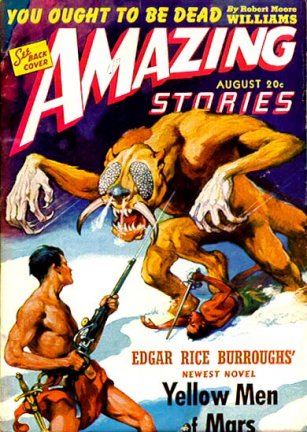 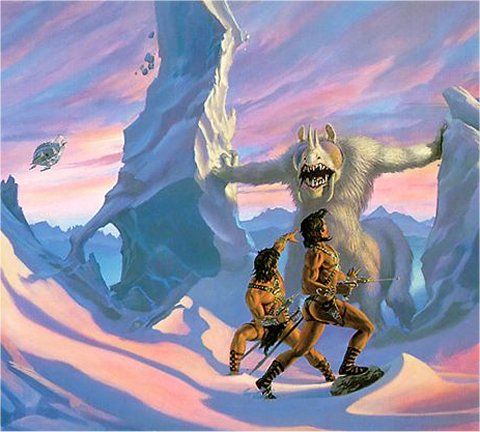 They are attacked by an apt, which I mention because the
scene appears both on the cover the original August 1941 issue of Amazing
Stories – drawn by J. Allen St. John – where it first appeared, and on
the cover of the Ballantine pocket book edition illustrated by Michael
Whelan. (See ERBzine #0738.)
We will discuss the drawing by J. Allen St. John in more detail below.
They are attacked by an apt, which I mention because the
scene appears both on the cover the original August 1941 issue of Amazing
Stories – drawn by J. Allen St. John – where it first appeared, and on
the cover of the Ballantine pocket book edition illustrated by Michael
Whelan. (See ERBzine #0738.)
We will discuss the drawing by J. Allen St. John in more detail below.
They survive the encounter, with Carter again saving the
life of Gor-don, and then come across the city:
“As we talked, we continued
on through the gorge; and presently came out upon a snow covered plain
upon which rose one of those amazing, glass covered, hot-house cities of
Barsoom’s North Polar region....
“Pankor was much like Kadabra, the
capital city of Okar, only much smaller. Though the country around it and
up to its walls was clothed in snow and ice, none lay upon the great crystal
dome which roofed the entire city; and beneath the dome, a pleasant, springlike
atmosphere prevailed. Its avenues were covered with the sod of the mosslike
ocher vegetation which clothes the sea bottoms of the red planet, and bordered
by well kept lawns of crimson Barsoomian grass. Along these avenues sped
the noiseless traffic of light and airy ground fliers which I had become
familiar in Marentina and Kadabra long years before.” (LG/III-11.)
As Gor-don’s personal bodyguard, Carter, passing himself
off again as Dotar Sojat, is given some liberty to explore the city. On
one of his outings, he is selected by an officer for a work patrol, and
it is here that he learns why the crew of the Dusar mutinied and what they
meant about being “frozen”:
“He led us out of the market
place and along an avenue of poorer shops, to the city wall. Here, beside
a small gate, was a shed in which was a stock of aptfur suits. After we
had each donned one of these, in accordance with the officer’s instructions,
he unlocked the small gate and led us out of the city into the bitter cold
of the Arctic, where such a sight met my eyes as I hope I may never see
again. On row after row of racks which extended as far as I could see hung
frozen human corpses, thousands upon thousands of them, hanging by their
feet, swinging in the biting wind.
“Each corpse was encased in ice,
a transparent shroud through which their dead eyes stared pleadingly, reproachfully,
accusingly, horribly. Some faces wore frozen grins, mocking Fate with bared
teeth.
“The officer had us cut down twenty
of the bodies, and the thought of the purpose for which they seemed obviously
intended almost nauseated me. As I looked upon those endless lines of corpses
hanging heads down, I was reminded of winter scenes before the butcher
shops of northern cities in my native country, where the bodies of ox and
bear and deer hung, frozen, for the gourmet to inspect.” (LG/III-12.)
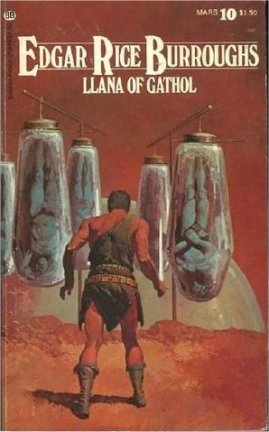 This scene, drawn by Gino D’Achille, can be found on the
Ballantine paper back cover in ERBzine
#0738. The frozen men are taken back to the city and thawed out, Carter
carrying one of them all by himself, attracting the attention of the officer.
As the thawed men come to, they are given harnesses and led away by an
attachment of warriors. The officer is impressed with Carter’s superhuman
strength, has him give a demonstration, then lets him go. When Carter returns
to Gor-don, he asks him the reason for the frozen men:
This scene, drawn by Gino D’Achille, can be found on the
Ballantine paper back cover in ERBzine
#0738. The frozen men are taken back to the city and thawed out, Carter
carrying one of them all by himself, attracting the attention of the officer.
As the thawed men come to, they are given harnesses and led away by an
attachment of warriors. The officer is impressed with Carter’s superhuman
strength, has him give a demonstration, then lets him go. When Carter returns
to Gor-don, he asks him the reason for the frozen men:
“‘It is part of Hin Abtol’s
mad scheme to conquer all of Barsoom and make himself Jeddak of Jeddaks
and Warlord of Barsoom. He has heard of the famous John Carter, who holds
these titles; and he is envious. He has been at the preserving of human
beings by freezing for fully a hundred years. At first it was only a plan
by which he might have great numbers of slaves available at any time without
the expense of feeding them while they were idle. After he heard of John
Carter and the enormous wealth of Helium and several other empires, this
grandiose scheme of conquest commenced taking form.
“‘He had to have a fleet; and as
no one in Pankor knew how to build airships, he had to acquire them by
trickery and theft. A few crossed the ice barrier from some of the northern
cities; these were lured to land by signals of friendship and welcome;
then their crews were captured and all but one or two of them frozen in.
Those who were not had promised to train Panars in the handling of the
ships. It has been a very slow process of acquiring a navy; but he has
supplemented it by visiting several of the northern cities, pretending
friendship, and then stealing a ship or two, just as he pretended friendship
for Gahan of Gathol and then stole his daughter.
“‘His present attack on Gathol is
merely a practice campaign to give his officers and warriors experience
and perhaps at the same time acquire a few more ships.’
“‘How many of those frozen men has
he?’ I asked.
“‘He has accumulated fully a million
in the last hundred years,’ replied Gor-don; ‘a very formidable army, if
he had the ships to transport them.’
“On this dying planet, the population
of which has been steadily decreasing for probably a million years, an
army of a million warriors would indeed be formidable; but led by Hin Abtol
and officered by Panars, two million disloyal warriors would be no great
menace to such a power as Helium.” (LG/III-12.)
The officer reports the strength of Dotar Sojat to Hin Abtol,
and the Jeddak demands that Gor-don transfer ownership to himself. He is
escorted to the palace and discovers on one side of it that his personal
flier – stolen by Hin Abtol in Horz – is displayed like a trophy. It is
here that he is pitted for the amusement of Hin Abtol against two adversaries,
Rab-zov, the strongest man
in Pankor, and then Ul-to, the greatest swordsman of
Pankor, both of whom he easily defeats.
His discovers that Llana of Gathol is beside Hin Abtol
in the crowd and subtlely directs her to the flier while he slowly hacks
Ul-to to pieces. He maneuvers Ul-to close to the flier just as Hin Abtol
notices Llana in the flier and calls an alarm. All hell breaks loose as
Carter finishes off Ul-to, Llana lifts off the flier, Carter leaps on board,
then together at last, they escape Pankor by crashing through the crystal
dome.

ANALYSIS

Those that claim that ERB was not a true science fiction
author can’t really have read about the Third Wonder of Barsoom. There
are more marvelous inventions in the hothouse cities than to be found in
most classic science fiction stories. Under these crystal domes, we find
sunray tanks and atmosphere factories generating summer and springlike
temperatures, airy ground fliers, a massive shaft-magnet, and an advanced
form of a law enforcement fax-like machine that is still futuristic even
by today's standards. Outside of the domes are terrible arctic monsters
and a million men frozen in suspended animation.
And ERB created almost all of these in 1913. No wonder
he revisited them again in 1940 when he wrote the four stories that make
up Llana of Gathol. It is noteworthy that two of these stories first
appeared under different names: “The Ancient Dead” first appeared in the
March 1941 issue of Amazing Stories as “The City of Mummies,” and “Escape
from Mars” first appeared in the August 1941 issue of Amazing Stories as
“The Yellow Men of Mars,” as the astute reader would have realized after
looking at the cover. (ERBzine
#0738.)
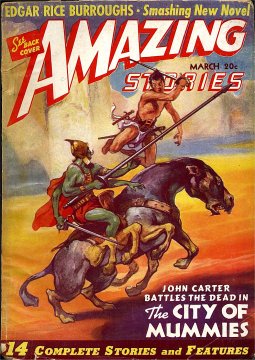 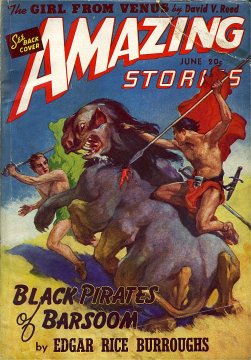
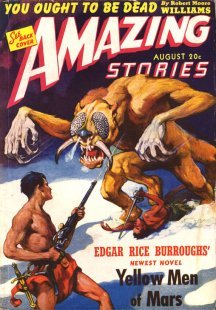 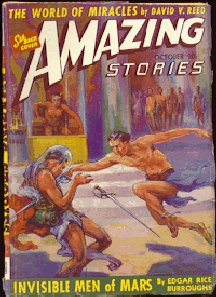
The dilemma raised by this title is obvious. The Panars,
unlike the Yellow Men from Okar, are Red Men. The only yellow man ever
mentioned is Talu, rebel prince of Marentina, and that mention only appears
in “The City of Mummies,” not in “The Yellow Men of Mars.” This really
disturbed me. What could possibly be the reason for this strange title?
Having studied political science in college in the late
Sixties and Early Seventies, with an emphasis on Soviet Foreign Policy,
my first theory was that because of the changing political climate between
1940 and 1948, ERB changed the Yellow Men into Red Men. The Japanese were
no longer a threat, while the Red Russians were.
Not having a copy of the original March and August 1941
editions of Amazing Stories, to compare with the 1948 edition of Llana
of Gathol, I was unable to confirm my theory and went to the only ERB
expert I could think of, the amazing George
McWhorter. It was his impression that Ray Palmer, who took over the
Ziff-Davis pulp magazines in 1939 came up with the title “Yellow Men of
Mars” because he thought it sounded catchy and would appeal to a wider
reading audience.
This answer was unappealing to me, so Mr. McWhorter then
went to his favorite ERB historian, Bob Barrett. His answer appears to
be dead on. Because, for whatever reason – probably color contrast with
a snow-white background – J. Allen St. John chose to color the apt on the
cover yellow instead of white. Wanting the cover to match with the title,
Palmer called the story “The Yellow Men of Mars.” Bizarre, yes. Crazy,
yes. But the truth is often stranger than fiction.
And there you have it, the Third Wonder of Barsoom:
The Hothouse Cities of Okar!
THE
SEVEN WONDERS OF BARSOOM SERIES
7
WONDERS: I | II
| III | IV
| V | VI
| VII
RUNNERS UP: I.a
| II | III
| IV | V
| VI | VII
| VIII.2.2b.3a.3b
| IX | X.2.3.4
| XI.2.3.4.5.6.|
|


